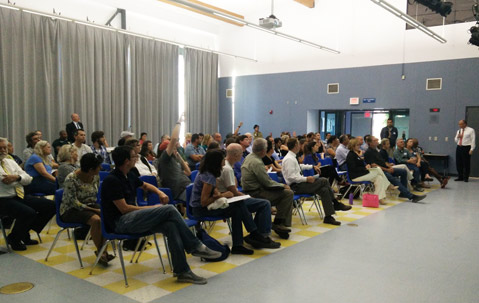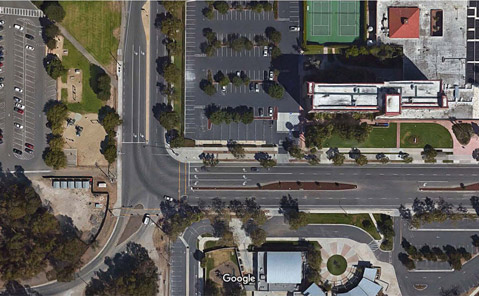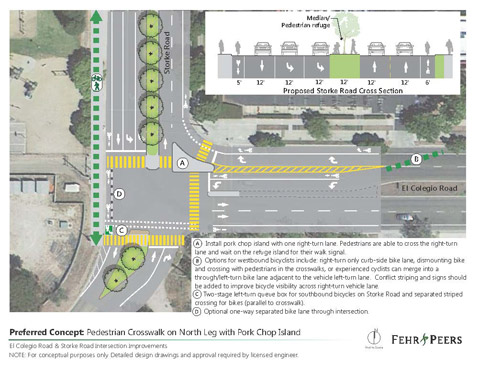I.V. Elementary Parents Critique New Storke, El Colegio Intersection Design

Isla Vista Elementary School parents put UCSB’s planned renovation of the Storke and El Colegio intersection through the wringer last Thursday evening during a presentation of an updated design.
Parents are concerned that the new configuration will put schoolchildren in danger when crossing the east leg of the intersection — the crosswalk that connects the route many students take from their homes in Storke Ranch and other nearby residential areas to the elementary school.
The construction will shrink the current three-way intersection by reducing the number of right turn lanes onto Storke Road from two to one. A triangular raised platform called a pork-chop island will replace one of the turn lanes in order to accommodate a new north-leg crosswalk. The idea behind the design is to allow pedestrians to use the north-, south-, and east-leg crosswalks without interrupting traffic making a westbound right turn. Once pedestrians reach the pork-chop island, they will be able to press a light signal that will make incoming traffic stop for a set amount of time.
The initial plan, designed by Fehr & Peers Transportation Consultants, did not include a crossing light at the right turn. Instead, it addressed the pedestrian flow by only adding a yield sign. After parents contacted the county and UCSB near the beginning of June with their concerns, a crossing light at the right turn was added.
Marc Fisher, vice chancellor for administrative services at UCSB, and Derek Rapp, traffic engineer at Stantec Consulting Services, addressed an audience of over 70 people for 30 minutes regarding that change. The following two hours were comprised of a Q&A segment where most questions still challenged the overall safety of the project.
Ilan Ben-Yaacov, a 15-year resident of Storke Ranch, voiced the major objection most attendees seemed to have: the inclusion of the north crosswalk and the pork-chop island.


“I really question whether this north crossing is actually needed,” Ben-Yaacov said. “In which case if the answer is no, then there’s no longer a necessity for this island.”
Ben-Yaacov said that the only people he could imagine using the north crosswalk are those using the nearby parking site north-west of the intersection. Those people, Ben-Yaacov said, would be using the new four-way intersection built in front of the Sierra Madre dorms, further reducing the amount of people utilizing the contested north crossing.
Fisher responded by saying that dining commons staff and university students living in the planned San Joaquin apartment complex would be utilizing the crosswalk. And that was when the cross-examination began. As Fisher responded to a question, another one instantly rang from the audience as a counter to the previous answer.
The meeting went on with a contentious tone for the rest of the evening, as people kept lambasting the project, with Fisher and Rapp defending their work.
“I have a question … that may put an end to all the other questions,” said Barbara Won, a Storke Ranch resident and I.V. Elementary parent. “I was just wondering if anything that we say or any concerns that we have are really going to change anything that you’re going to do.”
Rapp responded by saying that their input has already changed the design, referencing the added walking signal added in lieu of the yield sign. But when further pressed by Won on the possible removal of the pork-chop island and north crosswalk, Fisher said, “I don’t believe that’s a good idea.”
“I thought [this meeting] was a huge exercise in futility,” Won told The Santa Barbara Independent. “The meeting was there to make people feel like they got a chance to say something … Now they just have no more time to change the intersection … that’s the real issue — money and time.”
When asked if there was any chance of removing the north crossing and pork-chop island from the design after listening to the community, project manager Jennifer Pierce told The Independent no, but that other design changes will be looked into, including a driveway wrapped around the school to allow for another exit instead of just though El Colegio. Other possibilities included additional barriers to decrease jaywalking and increased signage.
The renovation comes as a result of UCSB’s ongoing Long Range Development Plan — an effort to increase housing capacity for students and faculty.
The San Joaquin apartment complex under construction is the main reason the intersection is being renovated. It will add 1,000 bed spaces to the area that, counted with the current 1,300 beds in the Santa Catalina towers, will bring the total number of bed spaces to 2,300, according to Fisher.
In addition, the 515 bed spaces in the Sierra Madre Villages that opened last year were also a heavy influence in the renovations.
Construction for the intersection is set to begin in two weeks, with an expected completion date in the first half of September. UCSB is paying for the design and construction.


